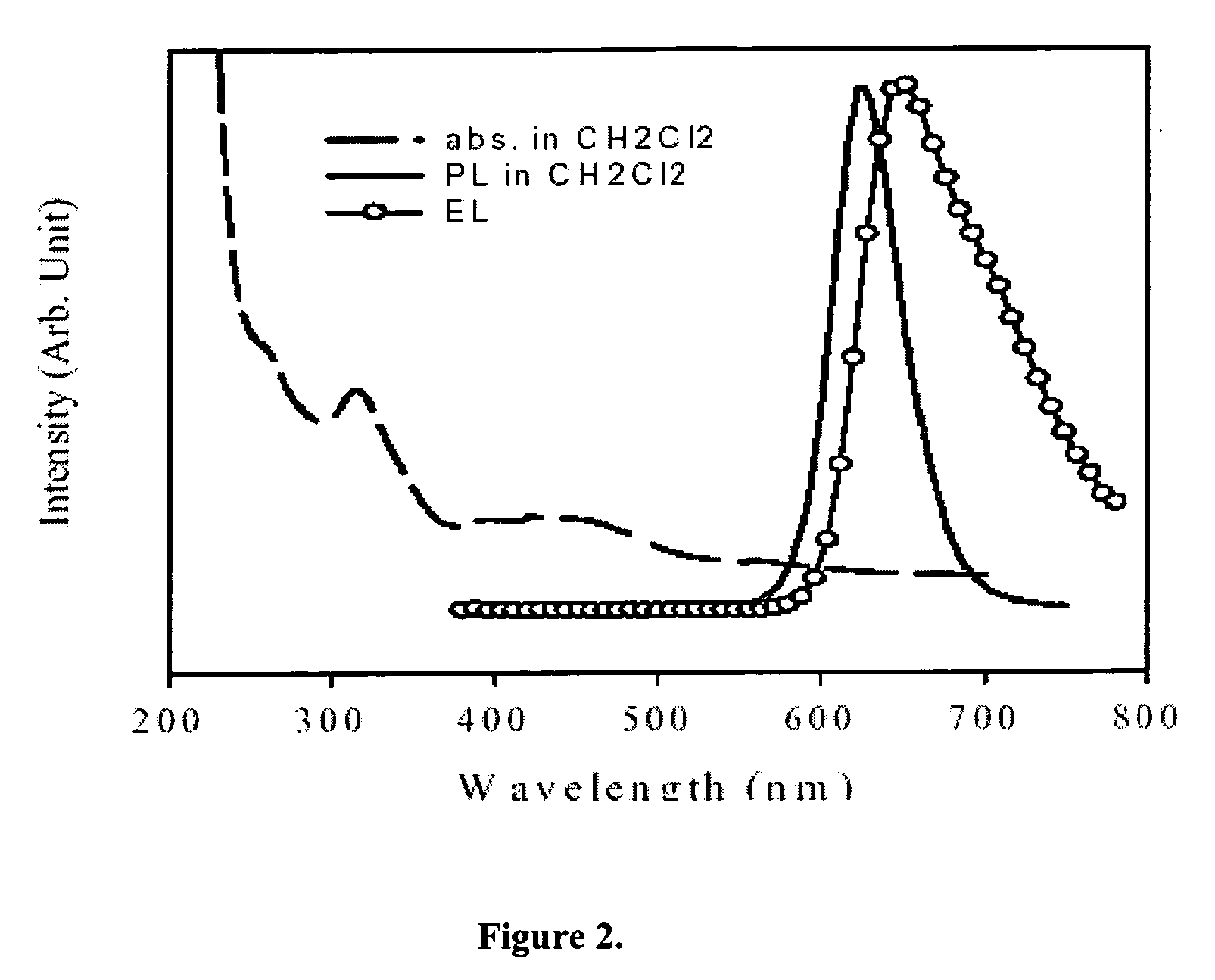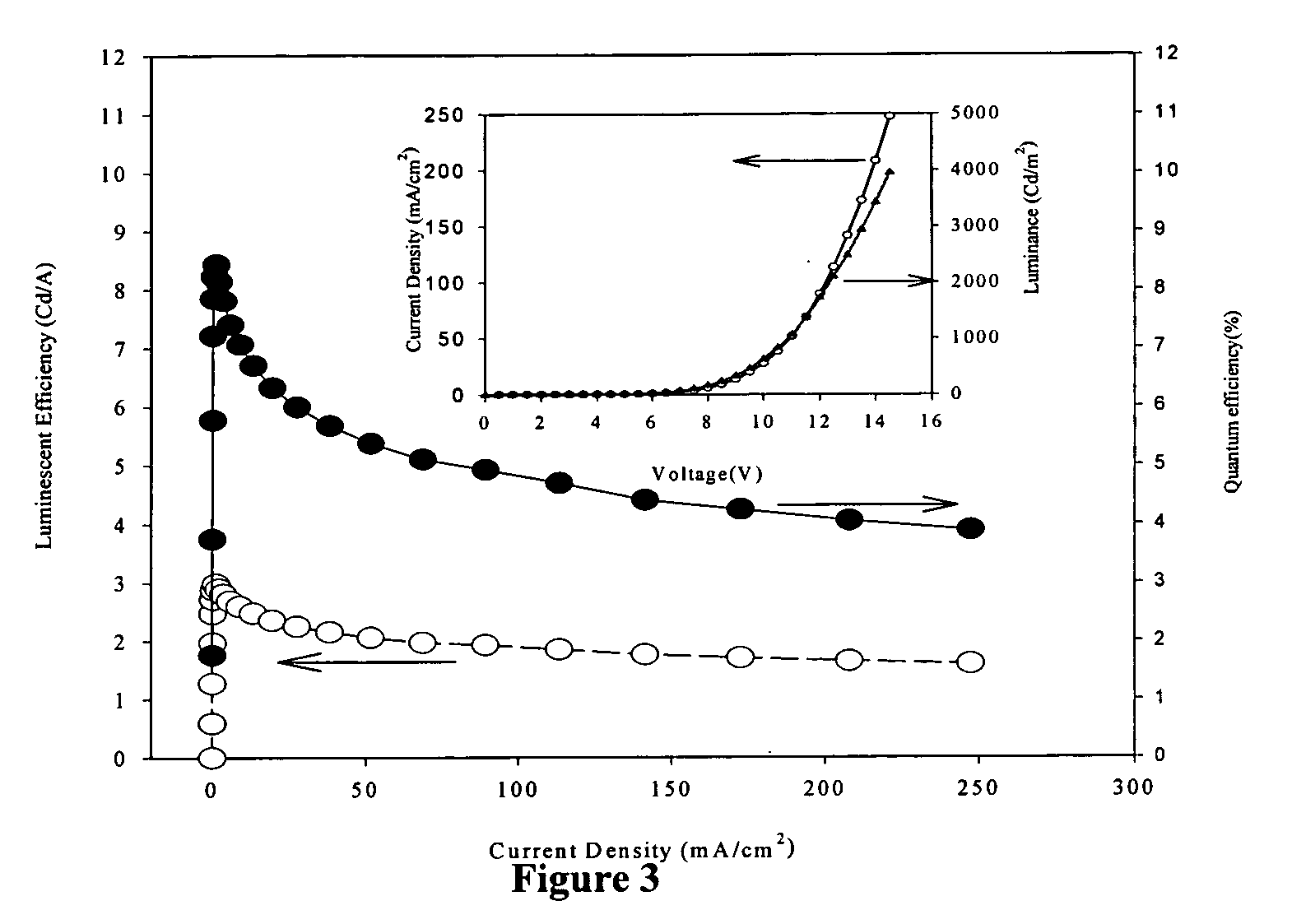Red-emitting electrophosphorescent devices
a technology of electrophosphorescence and red-emitting excitons, which is applied in the direction of luminescnet screens, discharge tubes, cadmium organic compounds, etc., can solve the problems of preventing efficient injection of carriers into the light-emitting layer, unable to convert excitons into energetically unfavorable higher singlet excited states, and unable to achieve the effect of efficient injection of carriers
- Summary
- Abstract
- Description
- Claims
- Application Information
AI Technical Summary
Benefits of technology
Problems solved by technology
Method used
Image
Examples
example 1
Synthesis of 1,4-Bis(phenyl)phthalazine
[0077] To a cooled solution of 1,2-bis(benzoyl)benzene (286.32, 0.5 g, 1.75 mmol) in glacial acetic acid (12 ml) was added hydrazine monohydrate (3.5 mL) dropwise. The reaction mixture was refluxed for 4 hours. The resulting bright brown solution was added with water to produce pale yellow precipitate, yield 100%. This was used to the next reaction for complex without further purification. MS: m / z 283.0 (M+).
example 2
Synthesis of Ir-Complex (Ir-BPPa)
[0078] 1,4-bis(phenyl)phthalazine (FW=282.34, 370 mg, 1.34 mmol) and Ir(acac)3 (FW=489.54, 164.3 mg, 0.336 mmol) were dissolved in degassed glycerol (10 ml). The reaction mixture was refluxed (220° C.) under nitrogen for 10 hours. Purple color precipitates turned out gradually during reflux. After reaction, the crude product was collected by filtration, washed with hexane and ether, dried in a vacuum (yield: 57%). It was then purified by flash-chromatographed on a silica gel column using dichlormethane as eluent. Addition of methanol to the solution followed by heating to boiling to evaporate dichloromethane resulted in precipitation of the product as dark-red color shining particles (40% yield). Melting point: 385.3° C.; 1H NMR: (Chloroform-d, 300 MHz) δ: 8.81 (d, 3H), 8.14 (d, 3H), 7.91 (d, 3H), 7.71 (t, 3H), 7.66 (m, 6H), 7.12 (m, 9H), 6.87 (t, 6H), 6.78 (d, 6H); MS: m / z (%) 1037.0 (100, M+), 755 (15, M+-BPPa); Calc. For C60H39N6Ir (FW=1036.32): ...
example 3
The Procedure of Electroluminescence Device Fabrication
[0079] An indium-tin-dioxide (ITO) coated glass substrate was sequentially untrasonicated in a detergent, rinsed in deionized water and exposed to UV light for 20 minutes, dried. A hole transporting layer of N,N′-bis-(1-naphthyl)-N,N′-diphenylbenzidine was deposited on ITO anode at the vacuum deposition rate about 15 nm / min. by using a tantalum boat to form a thickness of 60 nm. A light-emitting layer of CBP doped with a material with formula [I], [II], [III] was then co-deposited onto the hole-transporting layer with a thickness about 30 nm. The concentration of dopants can be controlled by deposition rate according to the requirement. At the following step, a hole blocking layer of TPBI was deposited onto the light-emitting layer with a thickness about 30 nm. An electron-transporting layer of AlQ3 was deposited onto the light-emitting layer with a thickness about 30 nm Then, a cathode consisted of a 10 / 1 atomic ratio of Mg / Ag...
PUM
| Property | Measurement | Unit |
|---|---|---|
| Luminescence | aaaaa | aaaaa |
Abstract
Description
Claims
Application Information
 Login to View More
Login to View More - R&D
- Intellectual Property
- Life Sciences
- Materials
- Tech Scout
- Unparalleled Data Quality
- Higher Quality Content
- 60% Fewer Hallucinations
Browse by: Latest US Patents, China's latest patents, Technical Efficacy Thesaurus, Application Domain, Technology Topic, Popular Technical Reports.
© 2025 PatSnap. All rights reserved.Legal|Privacy policy|Modern Slavery Act Transparency Statement|Sitemap|About US| Contact US: help@patsnap.com



